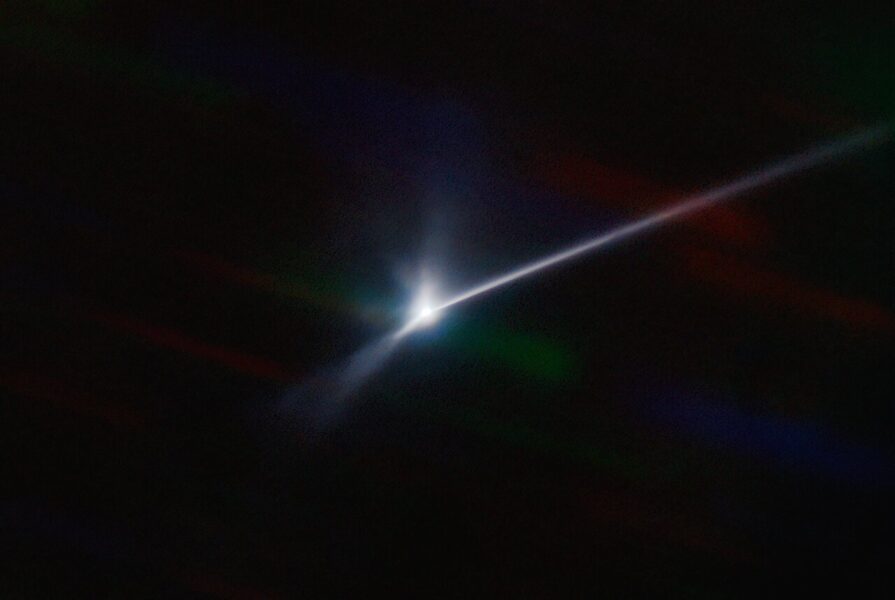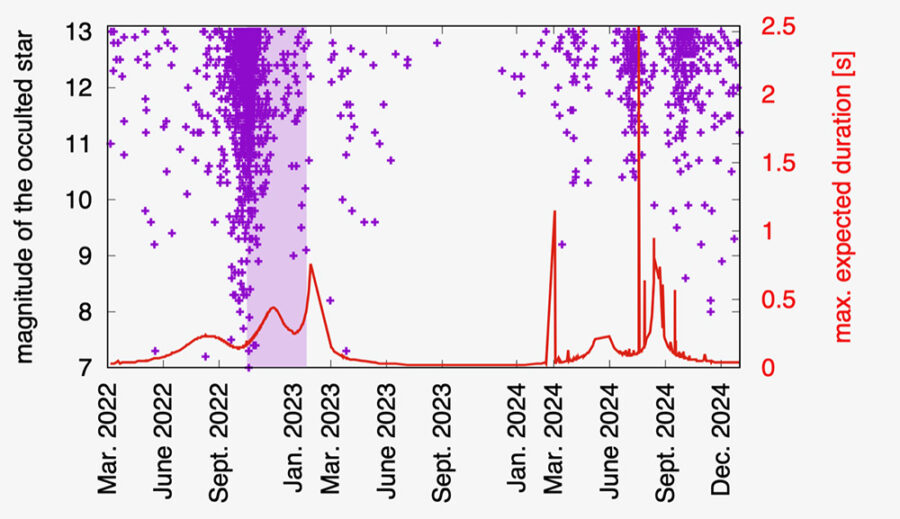Observers around the globe are keeping an eye on the asteroid Didymos and its moon Dimorphos to track the long-term effects of the DART mission’s impact.

CTIO / NOIRLab / SOAR / NSF / AURA / T. Kareta (Lowell Observatory), M. Knight (US Naval Academy); Image processing: T.A. Rector (University of Alaska Anchorage / NSF’s NOIRLab), M. Zamani & D. de Martin (NSF’s NOIRLab)
Amateur astronomers across the U.S., Japan, Western Europe and England, Algeria, and Australia are helping chase down the shadow of the Didymos-Dimorphos asteroid system as it passes in front of, or occults, distant stars. The observations are helping scientists evaluate the effect of the NASA’s Double Asteroid Redirection Test (DART) on Didymos’ orbit around the Sun.
The DART mission ran straight into Dimorphos, the moon of near-Earth asteroid 65803 Didymos, on September 26, 2022. The collision was intentional, designed to change the orbit of the moonlet, and perhaps one day avert a potential collision with Earth.
One of the groups following up on the impact is a French-Greek collaboration known as Asteroid Collaborative Research via Occultation Systematic Survey (ACROSS), initiated with the support of the European Space Agency, which ties together the professional and amateur communities in the hunt for stellar occultations by the Didymos system. Every time this asteroid pair blocks a background star, observers gather to watch in the hopes of tracing the position and shape of the asteroids and pin down their orbits. While professionals make the orbital computations and predictions for when and where to observe, amateurs across continents conduct most of the observations.
The asteroids’ shadow falls along a narrow path, and calculating exactly where the path will fall can be tricky. Sometimes amateurs go out to observe an expected event and see nothing at all. Such negative occultations serve to help rework the orbital model. So, although there were several misses prior to the DART impact, post-impact has seen a string of positive observations in late 2022 and January 2023.
Observers used mobile stations to successfully record 19 occultations, with multiple detections for most of the events. They even detected Dimorphos, which spans only 160 meters (520 feet), in three of these, making it the smallest object to be detected during an occultation.

Courtesy of Damya Souami
The stars recorded in each event between October 15, 2022, and January 21, 2023 ranged in magnitude from 9 to 13.5, making them visible to telescopes between 4.5 and 14 inches in aperture. In each case, the background star blinked out for only 0.15 to 0.36 seconds. Observers used high-speed cameras and GPS timings to ensure the highest time resolution and timing accuracy possible. Only a few large telescopes can guarantee equivalent results.
What’s more, these passionate volunteers often traveled hundreds of miles to the very narrow path of the asteroid’s shadow.
The DART team measured the change in Dimorphos’ orbit around Didymos using large telescopes. Space-based telescopes and a targeted mission — ESA’s Hera will rendezvous with the system in 2026— will continue to study the impact’s aftermath. But stellar occultations enable measurements not yet possible through other means, such as highly accurate astrometry. For example, ACROSS observations have enabled a measurement of the impact’s effect on the system’s orbit around the Sun, which is valuable in preparing for Hera’s mission.
At the same time, occultations are tricky. They require a net of observers ready to deploy across the shadow’s path. And not just any occultation will do: observers are limited by the magnitude of the star being occulted and the event’s duration.
The determination and perseverance of observers across the globe who responded to ACROSS’s call for observers has been key to the project’s success. They’ve been observing (and attempting to observe) occultations that last only a fraction of a second since mid-June last year and into February of this year. Bad weather plagued early attempts, which also involved fainter stars and briefer events.
However, after the DART impact Didymos crossed the Milky Way’s galactic plane, which meant it was passing in front of many brighter stars. That’s when observers caught most of the predicted events. Additional constraints from DART’s navigation system and radar observations collected around the impact date aided success.
As the first season of Didymos occultations is coming to an end, the ACROSS team, led by Paolo Tanga (Observatory of Côte d'Azur, France) and Kleomenis Tsiganis (University of Thessaloniki, Greece), is preparing for the next season starting in April 2024. We expect a high rate of success, because the set of occultations observed until now are constraining the orbit very well for next year’s period of visibility.
Planetary defense requires large international and inter-agency collaborations. Involving citizen scientists across the globe seems a natural extension of this effort, both to raise awareness and ensure success. Professional-amateur collaborations have proven once again that they can achieve great results.
We invite all observers to monitor the ACROSS website and activities and join us in 2024 as we continue to follow up on the Didymos system and other near-Earth asteroids.
 6
6








Comments
Alan Fitzsimmons
February 14, 2023 at 1:18 pm
A great article! But you imply Hera is both a rendezvous and a flyby. While that's kind of true, it's staying there for at least 6 months, along with its 2 cubesats.
You must be logged in to post a comment.
Monica Young
February 17, 2023 at 11:28 am
Hi Alan, yes, it's described as a rendezvous on the ESA website. I've corrected this sentence.
You must be logged in to post a comment.
Alex Pratt
February 17, 2023 at 4:39 pm
A very good article highlighting the nature of our pro-am collaborations. Such promotions of our work brings the value of occultation studies to the attention of more professional and amateur astronomers.
One minor point - in the 'purple' plot the descriptions of the y-axes have been transposed.
You must be logged in to post a comment.
Monica Young
February 17, 2023 at 5:31 pm
Thanks, I've fixed the caption!
You must be logged in to post a comment.
Greg-Bean
February 25, 2023 at 1:53 am
So I take it that there is not yet enough data to determine success or failure of DART? Saw no mention of that in your otherwise interesting article.
You must be logged in to post a comment.
Monica Young
February 27, 2023 at 9:33 am
Hi Greg, You can find more coverage on the DART impact here: https://skyandtelescope.org/astronomy-news/nasas-dart-mission-to-impact-asteroid/ and https://skyandtelescope.org/astronomy-news/dart-asteroid-redirect-test-wildly-successful/
You must be logged in to post a comment.
You must be logged in to post a comment.